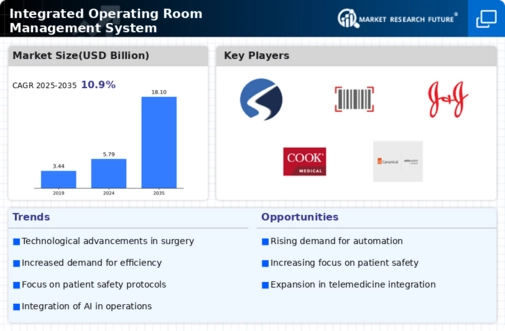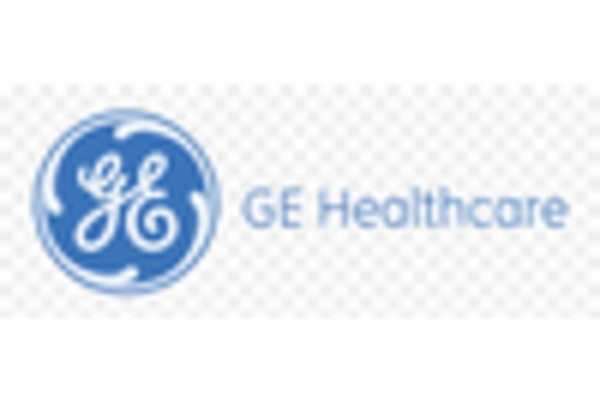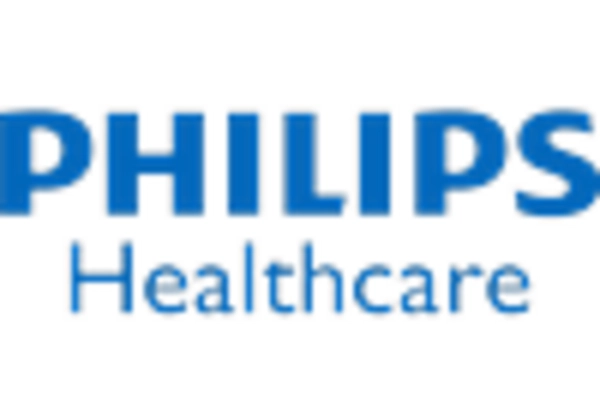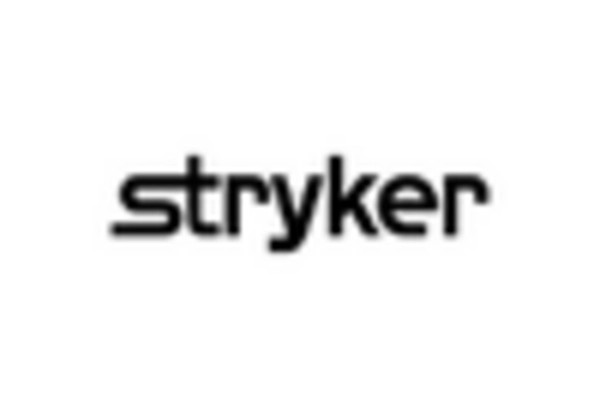-
Report Prologue
-
Market Introduction
-
Introduction 20
-
Assumptions & Limitations 20
-
Market Structure 20
-
Research Methodology
-
Research Process 22
-
Primary Research 22
-
Secondary Research 22
-
Market Size Estimation 23
-
Market Dynamics
-
Introduction 25
-
Drivers 25
- Increasing Number of Surgeries 25
- Favourable Reimbursement Policies 26
- Benefits of Minimum Congestion and Streamlined Flow of Information 26
- Drivers Impact Analysis 26
-
Restraints 27
- High Costs of Surgeries and Hospitalization 27
- Risk Factors Associated with Surgeries 27
- Restraints Impact Analysis 27
-
Opportunity 28
- The Rise of Medical Tourism in Asian countries 28
-
Market Factor Analysis
-
Value Chain Analysis 30
- R&D and Designing 30
- Manufacturing 30
- Distribution & Sales 31
- Post-sales Review 31
-
Porter’s Five Forces Model 32
- Bargaining Power of Suppliers 32
- Bargaining Power of Buyers 32
- Threat of New Entrants 33
- Threat of Substitutes 33
- Intensity of Rivalry 33
-
Integrated Operating Room Systems Market, by Device
-
Introduction 35
-
Operating Tables types 36
-
Operating Room Lights 36
-
Intraoperative Diagnostic Devices 36
-
Operating Room Communication Systems 37
-
Integrated Operating Room Systems Market, by Surgical Application
-
Introduction 39
-
Therapeutics Application 40
-
Diagnostics Imaging Application 40
-
Integrated Operating Room Systems Market, by Type
-
Introduction 42
-
Operating Room and Procedure Scheduling System 43
-
Recording and Documentation System 43
-
Instrument Tracking System 44
-
Audio and Video Management System 44
-
Operating Room Inventory Management System 44
-
Anesthesia Information Management 45
-
Global Integrated Operating Room Systems Market, by Region
-
Introduction 47
-
Americas 49
-
Integrated Operating Room Systems Market, by Device
-
Integrated Operating Room Systems Market, by Surgical Application
-
Integrated Operating Room Systems Market, by Type
-
North America 52
-
Integrated Operating Room Systems Market, by Device
-
Integrated Operating Room Systems Market, by Surgical Application
-
Integrated Operating Room Systems Market, by Type
-
US 55
-
Integrated Operating Room Systems Market, by Device
-
Integrated Operating Room Systems Market, by Surgical Application
-
Integrated Operating Room Systems Market, by Type
-
Canada 58
-
Integrated Operating Room Systems Market, by Device
-
Integrated Operating Room Systems Market, by Surgical Application
-
Integrated Operating Room Systems Market, by Type
-
South America 61
-
Integrated Operating Room Systems Market, by Device
-
Integrated Operating Room Systems Market, by Surgical Application
-
Integrated Operating Room Systems Market, by Type
-
Europe 64
-
Integrated Operating Room Systems Market, by Device
-
Integrated Operating Room Systems Market, by Surgical Application
-
Integrated Operating Room Systems Market, by Type
-
Western Europe 67
-
Integrated Operating Room Systems Market, by Device
-
Integrated Operating Room Systems Market, by Surgical Application
-
Integrated Operating Room Systems Market, by Type
-
Germany 70
-
Integrated Operating Room Systems Market, by Device
-
Integrated Operating Room Systems Market, by Surgical Application
-
Integrated Operating Room Systems Market, by Type
-
France 73
-
Integrated Operating Room Systems Market, by Device
-
Integrated Operating Room Systems Market, by Surgical Application
-
Integrated Operating Room Systems Market, by Type
-
U.K 76
-
Integrated Operating Room Systems Market, by Device
-
Integrated Operating Room Systems Market, by Surgical Application
-
Integrated Operating Room Systems Market, by Type
-
Italy 79
-
Integrated Operating Room Systems Market, by Device
-
Integrated Operating Room Systems Market, by Surgical Application
-
Integrated Operating Room Systems Market, by Type
-
Spain 82
-
Integrated Operating Room Systems Market, by Device
-
Integrated Operating Room Systems Market, by Surgical Application
-
Integrated Operating Room Systems Market, by Type
-
Rest of Western Europe 85
-
Integrated Operating Room Systems Market, by Device
-
Integrated Operating Room Systems Market, by Surgical Application
-
Integrated Operating Room Systems Market, by Type
-
Eastern Europe 88
-
Integrated Operating Room Systems Market, by Device
-
Integrated Operating Room Systems Market, by Surgical Application
-
Integrated Operating Room Systems Market, by Type
-
Asia Pacific 91
-
Integrated Operating Room Systems Market, by Device
-
Integrated Operating Room Systems Market, by Surgical Application
-
Integrated Operating Room Systems Market, by Type
-
India 95
-
Integrated Operating Room Systems Market, by Device
-
Integrated Operating Room Systems Market, by Surgical Application
-
Integrated Operating Room Systems Market, by Type
-
Australia 98
-
Integrated Operating Room Systems Market, by Device
-
Integrated Operating Room Systems Market, by Surgical Application
-
Integrated Operating Room Systems Market, by Type
-
Malaysia 101
-
Integrated Operating Room Systems Market, by Device
-
Integrated Operating Room Systems Market, by Surgical Application
-
Integrated Operating Room Systems Market, by Type
-
Singapore 104
-
Integrated Operating Room Systems Market, by Device
-
Integrated Operating Room Systems Market, by Surgical Application
-
Integrated Operating Room Systems Market, by Type
-
Taiwan 107
-
Integrated Operating Room Systems Market, by Device
-
Integrated Operating Room Systems Market, by Surgical Application
-
Integrated Operating Room Systems Market, by Type
-
Thailand 110
-
Integrated Operating Room Systems Market, by Device
-
Integrated Operating Room Systems Market, by Surgical Application
-
Integrated Operating Room Systems Market, by Type
-
Hong Kong 113
-
Integrated Operating Room Systems Market, by Device
-
Integrated Operating Room Systems Market, by Surgical Application
-
Integrated Operating Room Systems Market, by Type
-
Indonesia 116
-
Integrated Operating Room Systems Market, by Device
-
Integrated Operating Room Systems Market, by Surgical Application
-
Integrated Operating Room Systems Market, by Type
-
Rest of Asia Pacific 119
-
Integrated Operating Room Systems Market, by Device
-
Integrated Operating Room Systems Market, by Surgical Application
-
Integrated Operating Room Systems Market, by Type
-
Middle East & Africa 122
-
Integrated Operating Room Systems Market, by Device
-
Integrated Operating Room Systems Market, by Surgical Application
-
Integrated Operating Room Systems Market, by Type
-
Middle East 125
-
Integrated Operating Room Systems Market, by Device
-
Integrated Operating Room Systems Market, by Surgical Application
-
Integrated Operating Room Systems Market, by Type
-
Africa 128
-
Integrated Operating Room Systems Market, by Device
-
Integrated Operating Room Systems Market, by Surgical Application
-
Integrated Operating Room Systems Market, by Type
-
Competitive Landscape
-
Competitive Landscape 132
-
Company Profiles
-
Stryker Corporation. 134
- Financial Overview 134
- Products Offering 135
- Key Developments 135
- SWOT Analysis 135
- Key Strategy 135
-
Skytron, LLC 136
- Company Overview 136
- Financial Overview 136
- Products Offering 136
- Key Developments 136
- SWOT Analysis 136
- Key Strategy 137
-
Danaher Corporation (Leica Microsystems GmbH) 138
- Company Overview 138
- Financial Overview 138
- Products Offering 139
- Key Developments 139
- SWOT Analysis 139
- Key Strategy 139
-
Olympus Corporation of the Americas (Image Stream Medical, Inc.) 140
- Company Overview 140
- Financial Overview 140
- Products Offering 141
- Key Developments 141
- SWOT Analysis 141
- Key Strategy 141
-
Barco. 142
- Company Overview 142
- Financial Overview 142
- Products Offering 143
- Key Developments 143
- SWOT Analysis 143
- Key Strategy 143
-
Johnson & Johnson Services Inc. 144
- Company Overview 144
- Financial Overview 144
- Products Offering 145
- Key Developments 145
- SWOT Analysis 145
- Key Strategy 145
-
GE Healthcare 146
- Company Overview 146
- Financial Overview 146
- Products Offering 147
- Key Developments 147
- SWOT Analysis 147
- Key Strategy 147
-
Cook Medical 148
- Company Overview 148
- Financial Overview 148
- Products Offering 148
- Key Developments 148
- SWOT Analysis 149
- Key strategy 149
-
KARL STORZ GmbH & Co. KG 150
- Company Overview 150
- Financial Overview: 150
- Products Offering 150
- Key Developments 150
- SWOT Analysis 150
- Key strategy 151
-
Koninklijke Philips N.V. 152
- Company Overview 152
- Financial Overview 152
- Products Offering 153
- Key Developments 153
- SWOT Analysis 153
- Key Strategy 153
-
CANON INC. 154
- Company Overview 154
- Financial Overview 154
- Products Offering 155
- Key Developments 155
- SWOT Analysis 155
- Key Strategy 155
-
STERIS plc. 156
- Company Overview 156
- Financial Overview 156
- Products Offering 157
- Key Developments 157
- SWOT Analysis 157
- Key Strategy 157
-
Appendix 158
-
Discussion Blue Print 159
-
List of Tables
-
GLOBAL INTEGRATED OPERATING ROOM SYSTEMS MARKET BY DEVICE 2020-2027 (USD MILLION) 35
-
GLOBAL INTEGRATED OPERATING ROOM SYSTEMS MARKET BY OPERATING TABLES TYPES 2020-2027 (USD MILLION) 36
-
GLOBAL INTEGRATED OPERATING ROOM SYSTEMS MARKET BY OPERATING ROOM LIGHTS 2020-2027 (USD MILLION) 36
-
GLOBAL INTEGRATED OPERATING ROOM SYSTEMS MARKET BY INTRAOPERATIVE DIAGNOSTIC DEVICES
-
GLOBAL INTEGRATED OPERATING ROOM SYSTEMS MARKET BY OPERATING ROOM COMMUNICATION SYSTEMS
-
GLOBAL INTEGRATED OPERATING ROOM SYSTEMS MARKET BY SURGICAL APPLICATION 2020-2027 (USD MILLION) 39
-
GLOBAL INTEGRATED OPERATING ROOM SYSTEMS MARKET BY THERAPEUTICS APPLICATION 2020-2027 (USD MILLION) 40
-
GLOBAL INTEGRATED OPERATING ROOM SYSTEMS MARKET BY DIAGNOSTICS IMAGING APPLICATION
-
GLOBAL INTEGRATED OPERATING ROOM SYSTEMS MARKET BY SURGICAL APPLICATION 2020-2027 (USD MILLION) 42
-
GLOBAL INTEGRATED OPERATING ROOM SYSTEMS MARKET BY OPERATING ROOM AND PROCEDURE SCHEDULING
-
SYSTEM 2020-2027 (USD MILLION) 43
-
GLOBAL INTEGRATED OPERATING ROOM SYSTEMS MARKET BY RECORDING AND DOCUMENTATION SYSTEM
-
GLOBAL INTEGRATED OPERATING ROOM SYSTEMS MARKET BY INSTRUMENT TRACKING SYSTEM 2020-2027 (USD MILLION) 44
-
GLOBAL INTEGRATED OPERATING ROOM SYSTEMS MARKET BY AUDIO AND VIDEO MANAGEMENT SYSTEM
-
GLOBAL INTEGRATED OPERATING ROOM SYSTEMS MARKET BY AUDIO OPERATING ROOM INVENTORY MANAGEMENT
-
SYSTEM 2020-2027 (USD MILLION) 44
-
GLOBAL INTEGRATED OPERATING ROOM SYSTEMS MARKET BY ANESTHESIA INFORMATION MANAGEMENT
-
GLOBAL INTEGRATED OPERATING ROOM SYSTEMS MARKET BY REGION 2020-2027 (USD MILLION) 47
-
AMERICA INTEGRATED OPERATING ROOM SYSTEMS MARKET BY REGION 2020-2027 (USD MILLION) 49
-
AMERICAS INTEGRATED OPERATING ROOM SYSTEMS MARKET BY DEVICE 2020-2027 (USD MILLION) 49
-
AMERICAS INTEGRATED OPERATING ROOM SYSTEMS MARKET BY OPERATING TABLES TYPES 2020-2027 (USD MILLION) 50
-
AMERICAS INTEGRATED OPERATING ROOM SYSTEMS MARKET BY OPERATING ROOM LIGHTS 2020-2027 (USD MILLION) 50
-
AMERICAS INTEGRATED OPERATING ROOM SYSTEMS MARKET BY INTRAOPERATIVE DIAGNOSTIC DEVICES
-
AMERICAS INTEGRATED OPERATING ROOM SYSTEMS MARKET BY OPERATING ROOM COMMUNICATION SYSTEMS
-
AMERICAS INTEGRATED OPERATING ROOM SYSTEMS MARKET BY SURGICAL APPLICATION 2020-2027 (USD MILLION) 51
-
AMERICAS INTEGRATED OPERATING ROOM SYSTEMS MARKET BY THERAPEUTICS APPLICATION 2020-2027 (USD MILLION) 51
-
AMERICAS INTEGRATED OPERATING ROOM SYSTEMS MARKET BY DIAGNOSTICS IMAGING APPLICATION
-
AMERICAS INTEGRATED OPERATING ROOM SYSTEMS MARKET BY TYPES 2020-2027 (USD MILLION) 52
-
NORTH AMERICA INTEGRATED OPERATING ROOM SYSTEMS MARKET BY DEVICE 2020-2027 (USD MILLION) 52
-
NORTH AMERICA INTEGRATED OPERATING ROOM SYSTEMS MARKET BY OPERATING TABLES TYPES
-
NORTH AMERICA INTEGRATED OPERATING ROOM SYSTEMS MARKET BY OPERATING ROOM LIGHTS
-
NORTH AMERICA INTEGRATED OPERATING ROOM SYSTEMS MARKET BY INTRAOPERATIVE DIAGNOSTIC DEVICES
-
NORTH AMERICA INTEGRATED OPERATING ROOM SYSTEMS MARKET BY OPERATING ROOM COMMUNICATION SYSTEMS
-
NORTH AMERICA INTEGRATED OPERATING ROOM SYSTEMS MARKET BY SURGICAL APPLICATION 2020-2027 (USD MILLION) 53
-
NORTH AMERICA INTEGRATED OPERATING ROOM SYSTEMS MARKET BY THERAPEUTICS APPLICATION
-
NORTH AMERICA INTEGRATED OPERATING ROOM SYSTEMS MARKET BY DIAGNOSTICS IMAGING APPLICATION
-
NORTH AMERICA INTEGRATED OPERATING ROOM SYSTEMS MARKET BY TYPES 2020-2027 (USD MILLION) 54
-
U.S INTEGRATED OPERATING ROOM SYSTEMS MARKET BY DEVICE 2020-2027 (USD MILLION) 55
-
U.S INTEGRATED OPERATING ROOM SYSTEMS MARKET BY OPERATING TABLES TYPES 2020-2027 (USD MILLION) 55
-
U.S INTEGRATED OPERATING ROOM SYSTEMS MARKET BY OPERATING ROOM LIGHTS 2020-2027 (USD MILLION) 55
-
U.S INTEGRATED OPERATING ROOM SYSTEMS MARKET BY INTRAOPERATIVE DIAGNOSTIC DEVICES
-
U.S INTEGRATED OPERATING ROOM SYSTEMS MARKET BY OPERATING ROOM COMMUNICATION SYSTEMS
-
U.S INTEGRATED OPERATING ROOM SYSTEMS MARKET BY SURGICAL APPLICATION 2020-2027 (USD MILLION) 56
-
U.S INTEGRATED OPERATING ROOM SYSTEMS MARKET BY THERAPEUTICS APPLICATION 2020-2027 (USD MILLION) 57
-
U.S INTEGRATED OPERATING ROOM SYSTEMS MARKET BY DIAGNOSTICS IMAGING APPLICATION 2020-2027 (USD MILLION) 57
-
U.S INTEGRATED OPERATING ROOM SYSTEMS MARKET BY TYPES 2020-2027 (USD MILLION) 57
-
CANADA INTEGRATED OPERATING ROOM SYSTEMS MARKET BY DEVICE 2020-2027 (USD MILLION) 58
-
CANADA INTEGRATED OPERATING ROOM SYSTEMS MARKET BY OPERATING TABLES TYPES 2020-2027 (USD MILLION) 58
-
CANADA INTEGRATED OPERATING ROOM SYSTEMS MARKET BY OPERATING ROOM LIGHTS 2020-2027 (USD MILLION) 58
-
CANADA INTEGRATED OPERATING ROOM SYSTEMS MARKET BY INTRAOPERATIVE DIAGNOSTIC DEVICES
-
CANADA INTEGRATED OPERATING ROOM SYSTEMS MARKET BY OPERATING ROOM COMMUNICATION SYSTEMS
-
CANADA INTEGRATED OPERATING ROOM SYSTEMS MARKET BY SURGICAL APPLICATION 2020-2027 (USD MILLION) 59
-
CANADA INTEGRATED OPERATING ROOM SYSTEMS MARKET BY THERAPEUTICS APPLICATION 2020-2027 (USD MILLION) 60
-
CANADA INTEGRATED OPERATING ROOM SYSTEMS MARKET BY DIAGNOSTICS IMAGING APPLICATION
-
CANADA INTEGRATED OPERATING ROOM SYSTEMS MARKET BY TYPES 2020-2027 (USD MILLION) 60
-
SOUTH AMERICA INTEGRATED OPERATING ROOM SYSTEMS MARKET BY DEVICE 2020-2027 (USD MILLION) 61
-
SOUTH AMERICA INTEGRATED OPERATING ROOM SYSTEMS MARKET BY OPERATING TABLES TYPES
-
SOUTH AMERICA INTEGRATED OPERATING ROOM SYSTEMS MARKET BY OPERATING ROOM LIGHTS
-
SOUTH AMERICA INTEGRATED OPERATING ROOM SYSTEMS MARKET BY INTRAOPERATIVE DIAGNOSTIC DEVICES
-
SOUTH AMERICA INTEGRATED OPERATING ROOM SYSTEMS MARKET BY OPERATING ROOM COMMUNICATION SYSTEMS
-
SOUTH AMERICA INTEGRATED OPERATING ROOM SYSTEMS MARKET BY SURGICAL APPLICATION 2020-2027 (USD MILLION) 62
-
SOUTH AMERICA INTEGRATED OPERATING ROOM SYSTEMS MARKET BY THERAPEUTICS APPLICATION
-
SOUTH AMERICA INTEGRATED OPERATING ROOM SYSTEMS MARKET BY DIAGNOSTICS IMAGING APPLICATION
-
SOUTH AMERICA INTEGRATED OPERATING ROOM SYSTEMS MARKET BY TYPES 2020-2027 (USD MILLION) 63
-
EUROPE INTEGRATED OPERATING ROOM SYSTEMS MARKET BY REGION 2020-2027 (USD MILLION) 64
-
EUROPE INTEGRATED OPERATING ROOM SYSTEMS MARKET BY DEVICE 2020-2027 (USD MILLION) 64
-
EUROPE INTEGRATED OPERATING ROOM SYSTEMS MARKET BY OPERATING TABLES TYPES 2020-2027 (USD MILLION) 65
-
EUROPE INTEGRATED OPERATING ROOM SYSTEMS MARKET BY OPERATING ROOM LIGHTS 2020-2027 (USD MILLION) 65
-
EUROPE INTEGRATED OPERATING ROOM SYSTEMS MARKET BY INTRAOPERATIVE DIAGNOSTIC DEVICES
-
EUROPE INTEGRATED OPERATING ROOM SYSTEMS MARKET BY OPERATING ROOM COMMUNICATION SYSTEMS
-
EUROPE INTEGRATED OPERATING ROOM SYSTEMS MARKET BY SURGICAL APPLICATION 2020-2027 (USD MILLION) 66
-
EUROPE INTEGRATED OPERATING ROOM SYSTEMS MARKET BY THERAPEUTICS APPLICATION 2020-2027 (USD MILLION) 66
-
EUROPE INTEGRATED OPERATING ROOM SYSTEMS MARKET BY DIAGNOSTICS IMAGING APPLICATION
-
EUROPE INTEGRATED OPERATING ROOM SYSTEMS MARKET BY TYPES 2020-2027 (USD MILLION) 67
-
WESTERN EUROPE INTEGRATED OPERATING ROOM SYSTEMS MARKET BY DEVICE 2020-2027 (USD MILLION) 67
-
WESTERN EUROPE INTEGRATED OPERATING ROOM SYSTEMS MARKET BY OPERATING TABLES TYPES
-
WESTERN EUROPE INTEGRATED OPERATING ROOM SYSTEMS MARKET BY OPERATING ROOM LIGHTS
-
WESTERN EUROPE INTEGRATED OPERATING ROOM SYSTEMS MARKET BY INTRAOPERATIVE DIAGNOSTIC DEVICES
-
WESTERN EUROPE INTEGRATED OPERATING ROOM SYSTEMS MARKET BY OPERATING ROOM COMMUNICATION
-
SYSTEMS 2020-2027 (USD MILLION) 68
-
WESTERN EUROPE INTEGRATED OPERATING ROOM SYSTEMS MARKET BY SURGICAL APPLICATION
-
WESTERN EUROPE INTEGRATED OPERATING ROOM SYSTEMS MARKET BY THERAPEUTICS APPLICATION
-
WESTERN EUROPE INTEGRATED OPERATING ROOM SYSTEMS MARKET BY DIAGNOSTICS IMAGING APPLICATION
-
WESTERN EUROPE INTEGRATED OPERATING ROOM SYSTEMS MARKET BY TYPES 2020-2027 (USD MILLION) 69
-
GERMANY INTEGRATED OPERATING ROOM SYSTEMS MARKET BY DEVICE 2020-2027 (USD MILLION) 70
-
GERMANY INTEGRATED OPERATING ROOM SYSTEMS MARKET BY OPERATING TABLES TYPES 2020-2027 (USD MILLION) 70
-
GERMANY INTEGRATED OPERATING ROOM SYSTEMS MARKET BY OPERATING ROOM LIGHTS 2020-2027 (USD MILLION) 70
-
GERMANY INTEGRATED OPERATING ROOM SYSTEMS MARKET BY INTRAOPERATIVE DIAGNOSTIC DEVICES
-
GERMANY INTEGRATED OPERATING ROOM SYSTEMS MARKET BY OPERATING ROOM COMMUNICATION SYSTEMS
-
GERMANY INTEGRATED OPERATING ROOM SYSTEMS MARKET BY SURGICAL APPLICATION 2020-2027 (USD MILLION) 71
-
GERMANY INTEGRATED OPERATING ROOM SYSTEMS MARKET BY THERAPEUTICS APPLICATION 2020-2027 (USD MILLION) 72
-
GERMANY INTEGRATED OPERATING ROOM SYSTEMS MARKET BY DIAGNOSTICS IMAGING APPLICATION
-
GERMANY INTEGRATED OPERATING ROOM SYSTEMS MARKET BY TYPES 2020-2027 (USD MILLION) 72
-
FRANCE INTEGRATED OPERATING ROOM SYSTEMS MARKET BY DEVICE 2020-2027 (USD MILLION) 73
-
FRANCE INTEGRATED OPERATING ROOM SYSTEMS MARKET BY OPERATING TABLES TYPES 2020-2027 (USD MILLION) 73
-
FRANCE INTEGRATED OPERATING ROOM SYSTEMS MARKET BY OPERATING ROOM LIGHTS 2020-2027 (USD MILLION) 73
-
FRANCE INTEGRATED OPERATING ROOM SYSTEMS MARKET BY INTRAOPERATIVE DIAGNOSTIC DEVICES
-
FRANCE INTEGRATED OPERATING ROOM SYSTEMS MARKET BY OPERATING ROOM COMMUNICATION SYSTEMS
-
FRANCE INTEGRATED OPERATING ROOM SYSTEMS MARKET BY SURGICAL APPLICATION 2020-2027 (USD MILLION) 74
-
FRANCE INTEGRATED OPERATING ROOM SYSTEMS MARKET BY THERAPEUTICS APPLICATION 2020-2027 (USD MILLION) 75
-
FRANCE INTEGRATED OPERATING ROOM SYSTEMS MARKET BY DIAGNOSTICS IMAGING APPLICATION
-
FRANCE INTEGRATED OPERATING ROOM SYSTEMS MARKET BY TYPES 2020-2027 (USD MILLION) 75
-
U.K INTEGRATED OPERATING ROOM SYSTEMS MARKET BY DEVICE 2020-2027 (USD MILLION) 76
-
U.K INTEGRATED OPERATING ROOM SYSTEMS MARKET BY OPERATING TABLES TYPES 2020-2027 (USD MILLION) 76
-
U.K INTEGRATED OPERATING ROOM SYSTEMS MARKET BY OPERATING ROOM LIGHTS 2020-2027 (USD MILLION) 76
-
U.K INTEGRATED OPERATING ROOM SYSTEMS MARKET BY INTRAOPERATIVE DIAGNOSTIC DEVICES
-
U.K INTEGRATED OPERATING ROOM SYSTEMS MARKET BY OPERATING ROOM COMMUNICATION SYSTEMS
-
U.K INTEGRATED OPERATING ROOM SYSTEMS MARKET BY SURGICAL APPLICATION 2020-2027 (USD MILLION) 77
-
U.K INTEGRATED OPERATING ROOM SYSTEMS MARKET BY THERAPEUTICS APPLICATION 2020-2027 (USD MILLION) 78
-
U.K INTEGRATED OPERATING ROOM SYSTEMS MARKET BY DIAGNOSTICS IMAGING APPLICATION 2020-2027 (USD MILLION) 78
-
U.K INTEGRATED OPERATING ROOM SYSTEMS MARKET BY TYPES 2020-2027 (USD MILLION) 78
-
ITALY INTEGRATED OPERATING ROOM SYSTEMS MARKET BY DEVICE 2020-2027 (USD MILLION) 79
-
ITALY INTEGRATED OPERATING ROOM SYSTEMS MARKET BY OPERATING TABLES TYPES 2020-2027 (USD MILLION) 79
-
ITALY INTEGRATED OPERATING ROOM SYSTEMS MARKET BY OPERATING ROOM LIGHTS 2020-2027 (USD MILLION) 79
-
ITALY INTEGRATED OPERATING ROOM SYSTEMS MARKET BY INTRAOPERATIVE DIAGNOSTIC DEVICES
-
ITALY INTEGRATED OPERATING ROOM SYSTEMS MARKET BY OPERATING ROOM COMMUNICATION SYSTEMS
-
ITALY INTEGRATED OPERATING ROOM SYSTEMS MARKET BY SURGICAL APPLICATION 2020-2027 (USD MILLION) 80
-
ITALY INTEGRATED OPERATING ROOM SYSTEMS MARKET BY THERAPEUTICS APPLICATION 2020-2027 (USD MILLION) 81
-
ITALY INTEGRATED OPERATING ROOM SYSTEMS MARKET BY DIAGNOSTICS IMAGING APPLICATION
-
ITALY INTEGRATED OPERATING ROOM SYSTEMS MARKET BY TYPES 2020-2027 (USD MILLION) 81
-
SPAIN INTEGRATED OPERATING ROOM SYSTEMS MARKET BY DEVICE 2020-2027 (USD MILLION) 82
-
SPAIN INTEGRATED OPERATING ROOM SYSTEMS MARKET BY OPERATING TABLES TYPES 2020-2027 (USD MILLION) 82
-
SPAIN INTEGRATED OPERATING ROOM SYSTEMS MARKET BY OPERATING ROOM LIGHTS 2020-2027 (USD MILLION) 82
-
SPAIN INTEGRATED OPERATING ROOM SYSTEMS MARKET BY INTRAOPERATIVE DIAGNOSTIC DEVICES
-
SPAIN INTEGRATED OPERATING ROOM SYSTEMS MARKET BY OPERATING ROOM COMMUNICATION SYSTEMS
-
SPAIN INTEGRATED OPERATING ROOM SYSTEMS MARKET BY SURGICAL APPLICATION 2020-2027 (USD MILLION) 83
-
SPAIN INTEGRATED OPERATING ROOM SYSTEMS MARKET BY THERAPEUTICS APPLICATION 2020-2027 (USD MILLION) 84
-
SPAIN INTEGRATED OPERATING ROOM SYSTEMS MARKET BY DIAGNOSTICS IMAGING APPLICATION
-
SPAIN INTEGRATED OPERATING ROOM SYSTEMS MARKET BY TYPES 2020-2027 (USD MILLION) 84
-
REST OF WESTERN EUROPE INTEGRATED OPERATING ROOM SYSTEMS MARKET BY DEVICE 2020-2027 (USD MILLION) 85
-
REST OF WESTERN EUROPE INTEGRATED OPERATING ROOM SYSTEMS MARKET BY OPERATING TABLES TYPES
-
REST OF WESTERN EUROPE INTEGRATED OPERATING ROOM SYSTEMS MARKET BY OPERATING ROOM LIGHTS
-
REST OF WESTERN EUROPE INTEGRATED OPERATING ROOM SYSTEMS MARKET BY INTRAOPERATIVE DIAGNOSTIC
-
DEVICES 2020-2027 (USD MILLION) 86
-
REST OF WESTERN EUROPE INTEGRATED OPERATING ROOM SYSTEMS MARKET BY OPERATING ROOM
-
COMMUNICATION SYSTEMS 2020-2027 (USD MILLION) 86
-
REST OF WESTERN EUROPE INTEGRATED OPERATING ROOM SYSTEMS MARKET BY SURGICAL APPLICATION
-
REST OF WESTERN EUROPE INTEGRATED OPERATING ROOM SYSTEMS MARKET BY THERAPEUTICS APPLICATION
-
REST OF WESTERN EUROPE INTEGRATED OPERATING ROOM SYSTEMS MARKET BY DIAGNOSTICS IMAGING
-
APPLICATION 2020-2027 (USD MILLION) 87
-
REST OF WESTERN EUROPE INTEGRATED OPERATING ROOM SYSTEMS MARKET BY TYPES 2020-2027 (USD MILLION) 87
-
EASTERN EUROPE INTEGRATED OPERATING ROOM SYSTEMS MARKET BY DEVICE 2020-2027 (USD MILLION) 88
-
EASTERN EUROPE INTEGRATED OPERATING ROOM SYSTEMS MARKET BY OPERATING TABLES TYPES
-
EASTERN EUROPE INTEGRATED OPERATING ROOM SYSTEMS MARKET BY OPERATING ROOM LIGHTS
-
EASTERN EUROPE INTEGRATED OPERATING ROOM SYSTEMS MARKET BY INTRAOPERATIVE DIAGNOSTIC
-
DEVICES 2020-2027 (USD MILLION) 89
-
EASTERN EUROPE INTEGRATED OPERATING ROOM SYSTEMS MARKET BY OPERATING ROOM COMMUNICATION
-
SYSTEMS 2020-2027 (USD MILLION) 89
-
EASTERN EUROPE INTEGRATED OPERATING ROOM SYSTEMS MARKET BY SURGICAL APPLICATION 2020-2027 (USD MILLION) 89
-
EASTERN EUROPE INTEGRATED OPERATING ROOM SYSTEMS MARKET BY THERAPEUTICS APPLICATION
-
EASTERN EUROPE INTEGRATED OPERATING ROOM SYSTEMS MARKET BY DIAGNOSTICS IMAGING APPLICATION
-
EASTERN EUROPE INTEGRATED OPERATING ROOM SYSTEMS MARKET BY TYPES 2020-2027 (USD MILLION) 90
-
ASIA PACIFIC INTEGRATED OPERATING ROOM SYSTEMS MARKET BY REGION 2020-2027 (USD MILLION) 91
-
ASIA PACIFIC INTEGRATED OPERATING ROOM SYSTEMS MARKET BY DEVICE 2020-2027 (USD MILLION) 92
-
ASIA PACIFIC INTEGRATED OPERATING ROOM SYSTEMS MARKET BY OPERATING TABLES TYPES 2020-2027 (USD MILLION) 92
-
ASIA PACIFIC INTEGRATED OPERATING ROOM SYSTEMS MARKET BY OPERATING ROOM LIGHTS 2020-2027 (USD MILLION) 92
-
ASIA PACIFIC INTEGRATED OPERATING ROOM SYSTEMS MARKET BY INTRAOPERATIVE DIAGNOSTIC DEVICES
-
ASIA PACIFIC INTEGRATED OPERATING ROOM SYSTEMS MARKET BY OPERATING ROOM COMMUNICATION SYSTEMS
-
ASIA PACIFIC INTEGRATED OPERATING ROOM SYSTEMS MARKET BY SURGICAL APPLICATION 2020-2027 (USD MILLION) 93
-
ASIA PACIFIC INTEGRATED OPERATING ROOM SYSTEMS MARKET BY THERAPEUTICS APPLICATION 2020-2027 (USD MILLION) 94
-
ASIA PACIFIC INTEGRATED OPERATING ROOM SYSTEMS MARKET BY DIAGNOSTICS IMAGING APPLICATION
-
ASIA PACIFIC INTEGRATED OPERATING ROOM SYSTEMS MARKET BY TYPES 2020-2027 (USD MILLION) 94
-
INDIA INTEGRATED OPERATING ROOM SYSTEMS MARKET BY DEVICE 2020-2027 (USD MILLION) 95
-
INDIA INTEGRATED OPERATING ROOM SYSTEMS MARKET BY OPERATING TABLES TYPES 2020-2027 (USD MILLION) 95
-
INDIA INTEGRATED OPERATING ROOM SYSTEMS MARKET BY OPERATING ROOM LIGHTS 2020-2027 (USD MILLION) 95
-
INDIA INTEGRATED OPERATING ROOM SYSTEMS MARKET BY INTRAOPERATIVE DIAGNOSTIC DEVICES
-
INDIA INTEGRATED OPERATING ROOM SYSTEMS MARKET BY OPERATING ROOM COMMUNICATION SYSTEMS
-
INDIA INTEGRATED OPERATING ROOM SYSTEMS MARKET BY SURGICAL APPLICATION 2020-2027 (USD MILLION) 96
-
INDIA INTEGRATED OPERATING ROOM SYSTEMS MARKET BY THERAPEUTICS APPLICATION 2020-2027 (USD MILLION) 97
-
INDIA INTEGRATED OPERATING ROOM SYSTEMS MARKET BY DIAGNOSTICS IMAGING APPLICATION
-
INDIA INTEGRATED OPERATING ROOM SYSTEMS MARKET BY TYPES 2020-2027 (USD MILLION) 97
-
AUSTRALIA INTEGRATED OPERATING ROOM SYSTEMS MARKET BY DEVICE 2020-2027 (USD MILLION) 98
-
AUSTRALIA INTEGRATED OPERATING ROOM SYSTEMS MARKET BY OPERATING TABLES TYPES 2020-2027 (USD MILLION) 98
-
AUSTRALIA INTEGRATED OPERATING ROOM SYSTEMS MARKET BY OPERATING ROOM LIGHTS 2020-2027 (USD MILLION) 98
-
AUSTRALIA INTEGRATED OPERATING ROOM SYSTEMS MARKET BY INTRAOPERATIVE DIAGNOSTIC DEVICES
-
AUSTRALIA INTEGRATED OPERATING ROOM SYSTEMS MARKET BY OPERATING ROOM COMMUNICATION SYSTEMS
-
AUSTRALIA INTEGRATED OPERATING ROOM SYSTEMS MARKET BY SURGICAL APPLICATION 2020-2027 (USD MILLION) 99
-
AUSTRALIA INTEGRATED OPERATING ROOM SYSTEMS MARKET BY THERAPEUTICS APPLICATION 2020-2027 (USD MILLION) 100
-
AUSTRALIA INTEGRATED OPERATING ROOM SYSTEMS MARKET BY DIAGNOSTICS IMAGING APPLICATION
-
AUSTRALIA INTEGRATED OPERATING ROOM SYSTEMS MARKET BY TYPES 2020-2027 (USD MILLION) 100
-
MALAYSIA INTEGRATED OPERATING ROOM SYSTEMS MARKET BY DEVICE 2020-2027 (USD MILLION) 101
-
MALAYSIA INTEGRATED OPERATING ROOM SYSTEMS MARKET BY OPERATING TABLES TYPES 2020-2027 (USD MILLION) 101
-
MALAYSIA INTEGRATED OPERATING ROOM SYSTEMS MARKET BY OPERATING ROOM LIGHTS 2020-2027 (USD MILLION) 101
-
MALAYSIA INTEGRATED OPERATING ROOM SYSTEMS MARKET BY INTRAOPERATIVE DIAGNOSTIC DEVICES
-
MALAYSIA INTEGRATED OPERATING ROOM SYSTEMS MARKET BY OPERATING ROOM COMMUNICATION SYSTEMS
-
MALAYSIA INTEGRATED OPERATING ROOM SYSTEMS MARKET BY SURGICAL APPLICATION 2020-2027 (USD MILLION) 102
-
MALAYSIA INTEGRATED OPERATING ROOM SYSTEMS MARKET BY THERAPEUTICS APPLICATION 2020-2027 (USD MILLION) 103
-
MALAYSIA INTEGRATED OPERATING ROOM SYSTEMS MARKET BY DIAGNOSTICS IMAGING APPLICATION
-
MALYAYSIA INTEGRATED OPERATING ROOM SYSTEMS MARKET BY TYPES 2020-2027 (USD MILLION) 103
-
SINGAPORE INTEGRATED OPERATING ROOM SYSTEMS MARKET BY DEVICE 2020-2027 (USD MILLION) 104
-
SINGAPORE INTEGRATED OPERATING ROOM SYSTEMS MARKET BY OPERATING TABLES TYPES 2020-2027 (USD MILLION) 104
-
TA

















Leave a Comment